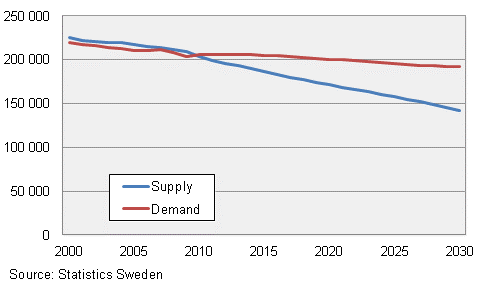Theme Labour Market – Engineers:
Shortage of engineers despite increased engineering education
Statistical news from Statistics Sweden 2013-03-11 9.30
Engineering programmes have become more popular in recent years. At the same time, the proportion of new students who actually complete their engineering education and earn a degree is decreasing. According to Statistics Sweden’s forecast, there will be a shortage of at least 30 000 people with a formal engineering education by 2030.
Interest in engineering education has increased in recent years from a low point in 2007/08. In the autumn term 2012, 7 000 students began studying towards a Master of Science in engineering, the highest number since 2002.
Even bachelor level engineering programmes have attracted more students, from roughly 3 200 in 2007/08 to about 5 100 in the autumn term 2012. There are now 1.5 applicants for each available place in masters engineering programmes and 1.1 applicants for bachelors engineering programmes.
Despite this increase, the proportion of Master of Science engineering students who actually complete their engineering education and earn a degree is falling, for both men and women. Among first year students in the 2002/03 academic year, only 51 percent had earned a degree within eight years, 59 percent of the women and 49 percent of the men.
The completion rate in bachelor level engineering programmes is even lower. Of the first year students in the 2000/01–2004/05 academic year, just over 30 percent had earned a degree within six years of beginning their studies.
Many educated engineers have a non-engineering occupation
A large part of the labour market for persons with an engineering education consists of non-engineering jobs. Among persons with a Master of Science engineering education, just 33 percent work in an occupation classified as civil engineer, architect, etc., and an additional 11 percent work as an engineer/technician. Among bachelor level engineers, we find 20 percent in the occupational category engineer, architect, etc., and 26 percent in the category engineer/technician.
However, a majority of persons with an engineering education have some sort of technical occupation, 58 percent of persons with a master’s level engineering education and 62 percent of persons with bachelor level engineering education.
To work in a leadership position is twice as common among those with a masters engineering education as it is among those with bachelors engineering education. One of five persons with a masters engineering education has such an occupation, but just one of ten persons with a bachelor’s level engineering education.
| [1] | Highest level of education | ||
|---|---|---|---|
| Masters in engineering [2, 3] | Bachelors in engineering [4] | ||
|
Managers
|
18 | 9 | |
|
Civil engineers, architect, etc.
|
33 | 20 | |
|
Engineer and technician
|
11 | 26 | |
|
Computer specialist
|
14 | 13 | |
|
Computer technician and data operator
|
1 | 3 | |
|
Physicist, chemist
|
2 | 0 | |
|
Business economist, marketer, human resource specialist
|
5 | 2 | |
|
University professor, college teacher
|
3 | 0 | |
|
Administrator in public sector
|
2 | 1 | |
|
Salesperson, procurement specialist, estate agent, etc.
|
5 | 6 | |
|
Other occupation which normally requires post-secondary education
|
4 | 7 | |
|
Other occupation which normally requires secondary education
|
3 | 11 | |
|
Other occupation which normally requires no specific level of education
|
0 | 1 | |
|
Total (percent)
|
100 | 100 | |
|
Total (number)
|
80 912 | 42 452 | |
[1] Population includes employed persons who were not students in the autumn term whose occupation is classified based on their primary occupation. [2] Occupational group Architects/City Planners is not included here. [3] Educational group Masters in Engineering includes studies at the doctoral level, as well as most masters-level programmes. [4] Educational group Bachelors in Engineering engineering includes bachelor-level and selected masters-level programmes. Source: Education and Occupation Registers, Statistics Sweden
Shortage of educated engineers
Employers have for many years communicated that there is a shortage of experienced engineers and other technical professionals. According to Statistics Sweden’s calculations, there will be a shortage of roughly 50 000 persons with a formal engineering education by the year 2030.
The shortage will be partially compensated by persons with similar competence, for example people with partially completed studies in technical areas but who lack a degree, and also by persons with non-engineering post-secondary degrees in technical- and manufacturing-related areas.
If 40 percent of the forecasted shortage is covered by such people, there will still be a shortage of 30 000 persons with a formal engineering education. To increase the supply by 30 000 by the year 2030, upper secondary-level engineering education should be reintroduced and significantly expanded. Alternatively, the number of persons who begin studying engineering at the post-secondary level should double from the 2013/2014 academic year, which translates to roughly 9 000 new first year students per year.

Publication
Feel free to use the facts from this statistical news but remember to state Source: Statistics Sweden.
